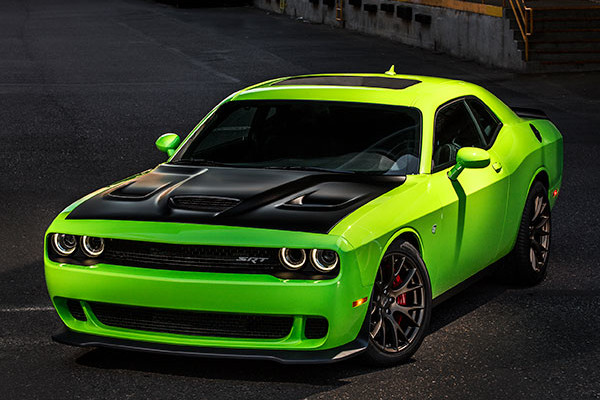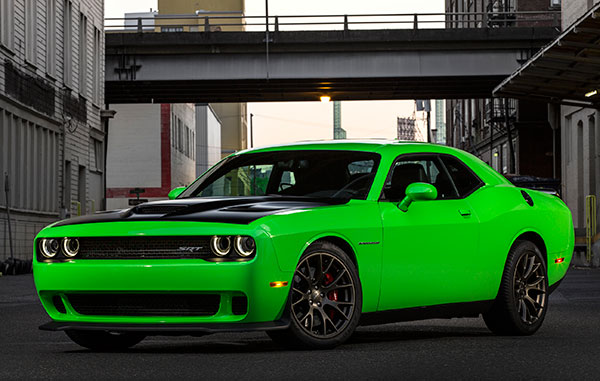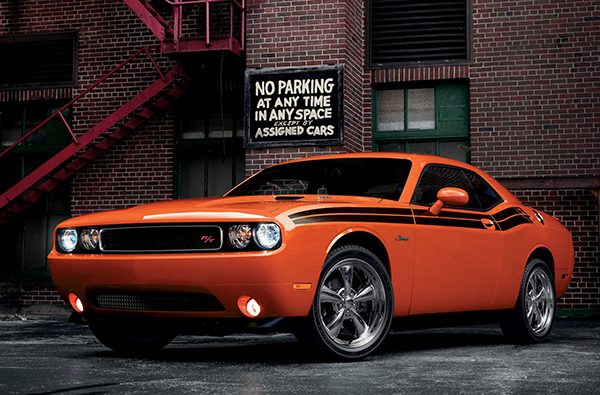

an account. You can:
Access your saved cars on any device.
Receive Price Alert emails when price changes,
new offers become available or a vehicle is sold.


Model Overview of The Dodge Challenger's For Sale in Middletown, CT
2016 Dodge Challenger Information
2016 Dodge Challenger
Big and heavy, the 2016 Dodge Challenger offers more touring comfort than other muscle cars. The Challenger is a two-door coupe, but its a bigger car than the Ford Mustang and Chevrolet Camaro. A diversity of models and a variety of engines lets owners choose a comfortable daily driver, a dragstrip battler, an outrageous Hellcat, or a colorful reminder of the past.
Exterior design follows patterns from the classic original Challenger, launched back in 1971. Challenger has always been known as the largest, most blocky-looking American muscle car, intensifying its road presence. Revived for 2008, the modern version is more touring coupe than raucous plaything: vigorous but comfortable, delivering a surprisingly supple ride.
Following a freshening for 2015, the new Blacktop Appearance group is available for the 2016 Challenger, with black accents and available Plum Crazy paint. The Hellcat gains Laguna leather.
Picking a favorite isnt easy, with 10 versions available: Challenger SXT, SXT Plus, R/T, R/T Plus, R/T Shaker, R/T Plus Shaker, R/T Scat Pack, 392 Hemi Scat Pack Shaker, SRT 392, and the SRT Hellcat. The customization option means no two Challengers are exactly alike.
A 305-horsepower 3.6-liter V6 comes in the Challenger SXT. The 5.7-liter Hemi V8, standard in R/T, is rated at 375 horsepower and 410 pound-feet of torque. Next up, in the SRT 392 and R/T Scat Pack, is a 6.4-liter Hemi V8 that produces 485 horsepower and 475 pound-feet. Top dog is the supercharged 6.2-liter V8 in the SRT Hellcat, whipping up 707 horsepower and 650 pound-feet.
All four engines mate with an 8-speed automatic transmission, with paddle shifters and Sport Mode. A 6-speed manual gearbox remains available for V8 models. Like all three competitors, the Challenger has a rear-wheel-drive layout with independent rear suspension. Suspension tuning varies according to model. The 2016 Challenger SXT is a little firmer than the 2015 version.
Despite its size and retro look, getting into the back seat is awkward, and visibility is poor. Fuel consumption wins no prizes, either.
Safety ratings score well. The National Highway Traffic Highway Safety Administration gives a five-star rating overall, with a five-star rating for side impacts and four stars for frontal impacts.
2015 Dodge Challenger Information
2015 Dodge Challenger
It was a minor player in the dawn of the pony car era, but as Dodge rolls into its second century, the 2015 Challenger looms as a powerful presence, upstaging Fords Mustang and the Chevy Camaro with a potent array of engines, including one that packs the biggest kick of all.
The power lineup starts with 305 horsepower, the output of the 3.6-liter V6 that propels the basic Challenger SXT, and now includes the new Hellcat V8, a supercharged 6.2-liter variant of Chryslers naturally aspirated 6.4-liter V8. Its rated for a prodigious 707 horsepower, the most powerful passenger car engine ever offered by Chrysler and also the most powerful in the contemporary pony car corral.
Engine options for the rest of the 2015 Dodge Challenger pale a bit in comparison to the Hellcat, but are heavy hitters in their own right: a 5.7-liter Hemi (372 hp) and the 6.4-liter Hemi, aka the 390 (485 hp). Chryslers 8-speed automatic transmission is available across the board, and new to the Challenger inventory for 2015. Its the only transmission offered with the basic SXT model, while a 6-speed manual is available with most of the V8s.
The sheetmetal surrounding all this power is new, but thats not readily apparent. Dodge has been faithful to the original Challenger styling, and that continues to be true of the redesign, with one proviso: the current Challenger was faithful to the 1970 original. The 2015 version is faithful to 1971. That model year, its second on the market, marked the zenith of Challenger performance, the final year with the option of 426 Hemi V8 muscle.
The design distinctions between 1970 and 71 were subtle, and thats true of the 2015 update. The front and rear fascias have been restyled, a thinner split grille slot (this varies according to trim levels), deeper airdam, an LED halo surrounding the quad headlights, a bigger power bulge in the new hood, a new Shaker hood option, and LED taillights.
But like the transition from 1970 to 71, the Challengers 2015 profile is essentially the same as 2014. Thats also true of the structure, although the rear axle housing is cast aluminum, rather than iron. And the retro theme is amplified visually by color choices drawn from the glory years, high-impact heritage hues, according to Dodge: B5 Blue, Tor Red, and Sublime. The last one is an electric green thats probably visible even in dense fog. There are also seven heritage-inspired stripe options.
While the exterior maintains close ties to the early 70s, the all-new interior is a blend of retro design and contemporary technology. There are 14 different interior package choices. Highlights under this heading include a new 7-inch TFT cluster nestled between the tachometer and speedometer with programmable information via Dodges Performance Pages feature; a new 8.4-inch touchscreen option with Chryslers U-Connect telematics; driver selectable operating modes; a variety of performance tracking features; and a new rearview camera. An S3 card slot, auxiliary audio input and USB outlet are integrated into a new media hub housed in the center armrest.
The front seats have been redesigned, with upholstery choices ranging from cloth to Nappa leather, and the option of heating and cooling for those clad with hides. Theres also a performance seat option with heftier thigh and torso bolstering for the front buckets. Dodge claims more rear-seat legroom for the Challenger versus Mustang and Camaro, but this distinction seems academic.
Essentially a two-door version of the Charger sedan, the Challenger is a big car by pony standards, and its heavy, most models weighing more than two tons. The SRT and Dodge chassis engineers have done a commendable job of tuning the suspension to manage the mass, and the brake packages seem equal to arresting it from high speeds with minimal drama and zero fade. And of course 707 hp can do wonders when it comes to minimizing mass, an original pony car theory that still applies.
We still revere the pony cars of yesteryear. Cars like Hemi Barracudas regularly command auction prices running north of the $1 million frontier. While the original muscle era produced some memorable power-to-weight ratios, the latest Challenger lineup, particularly the Hellcat version, puts them on the trailer. And in addition, the contemporary Challengers add a couple of capabilities that were all but absent in the originals: theyll stop and turn.
2013 Dodge Challenger Information
2013 Dodge Challenger
The Dodge Challenger brings muscle car performance and styling to everyday driving. It's an enjoyable car to drive. The Challenger harkens back to 1970, and the current generation, launched as a 2008 model, amuses and delights us. The 2013 model year brings a new Rallye Redline appearance package, updates to the optional navigation system and, for the top-performing SRT8 392, standard launch control, three-mode adaptive damping, and five new paint colors.
The base Challenger SXT comes reasonably well equipped and gives you the Challenger look and room for a modest price. Its 3.6-liter Pentastar V6 produces 305 horsepower and 268 foot-pounds of torque. But the Challenger is a big car, so even with a 5-speed automatic fuel economy is not its forte: Challenger is EPA rated 18/27 mpg City/Highway.
The Challenger R/T rumbles with a 5.7-liter Hemi V8. The V8 is rated at 372 hp and 400 pound-feet of torque with the 5-speed automatic, or 375 hp and 410 pound-feet of torque with the standard 6-speed manual. The Hemi uses a multiple displacement feature that switches off cylinders to save fuel, but EPA ratings are no better than 16/25 mpg. We think the Challenger R/T is a sweet spot in the lineup. It can be used as a daily driver with less intensity than the SRT8 (and considerable cost savings) yet it's sportier and more fun than the SXT. Challenger R/T is often compared with the Mustang GT and Camaro SS, although Challenger is a bigger car and a more comfortable cruiser.
The Challenger SRT8 392 is named after its Hemi V8's cubic-inch displacement (even though it's actually 391) and that of the legendary Hemi 392 engine of the late 1950s. The 2013 Challenger SRT8 392 comes with a 470-hp 6.4-liter Hemi V8 that also uses cylinder deactivation technology. EPA ratings are 14/23 mpg. Additional features include a heated steering wheel, three-mode adaptive damping and launch control. The SRT8 also comes with big Brembo brakes, the firmest suspension and a limited-slip rear differential. We found the SRT8 392 fast and stable. It's ready to go to the track yet we think it's compliant and controlled enough that it you can drive it daily or just for weekend cruises.
The Challenger is an enjoyable muscle car. Driving it brings a smile to our face and it seems to light up others as well. Everyone seems to like the Challenger. We've driven all the models and like all of them. They all have their own merits but there are distinctions.
The cabin is mundane. Like muscle cars of the past, the Challenger is based on a sedan (the Charger) and the interior borrows heavily from existing materials. The 392 sport seats hold you in place in corners and are designed to accommodate large drivers. Climbing into the back seat is a chore but once in we found it's fine for children, teens and the occasional adults.



